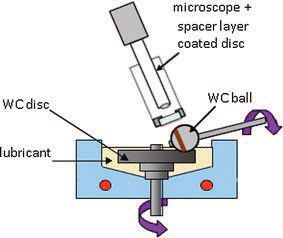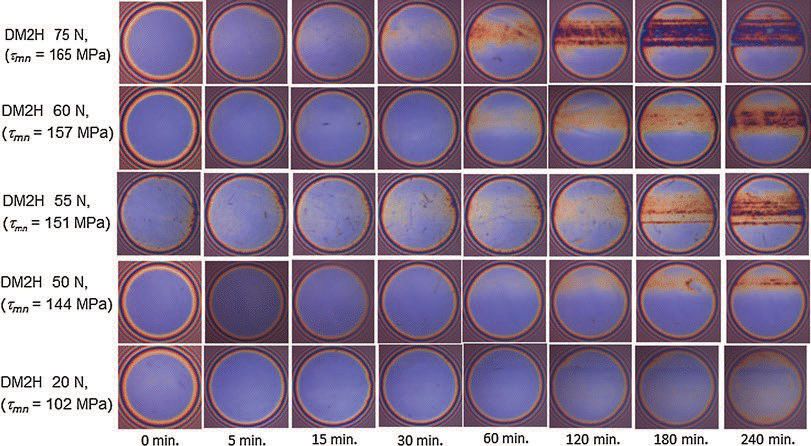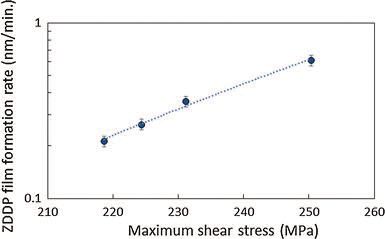The shear truth about ZDDP
Drs. Wilfred T. Tysoe & Nicholas D. Spencer | TLT Cutting Edge October 2016
Insights could lead to a more rational design of lubricant additives.
THE FORMATION OF TRIBOFILMS IN FLUIDS where there is no direct contact between the surfaces reveals that the reaction rate increases exponentially with the shear stress in the fluid.
A recent Cutting Edge article described experiments carried out using an atomic force microscope that demonstrated that interfacial shear could accelerate the rates of tribochemical reactions where the reaction rate increases exponentially with shear stress (
1). The article posed the question of whether such shear effects also occur for real engineered surfaces where other effects such as flash temperature increases, pressure, triboelectron emission or surface-catalyzed reactions at the contacting asperities also could accelerate reaction rates.
This question was explored for antiwear film formation from zinc dialkyldithiophosphate (ZDDP), perhaps the oldest and probably the most studied lubricant additive, by Professor Hugh Spikes and Dr. Jie Zhang from Imperial College in London, England (
2).
To avoid direct contact between the surfaces, the authors used a mini-traction machine (
see Figure 1) that allowed the slide-to-roll ratio to be adjusted to combine high entrainment speeds to form fluid films that were thicker than the surface roughness, with slower sliding speeds to adjust the shear. The absence of solid-solid contacts at the interface and the low sliding speed eliminated the effects described above. The system also allowed the film thickness to be periodically monitored by interferometry to measure film growth rates.
 Figure 1. MTM-SLIM set up. The rubbed track on the ball is shown in brown. (Published with permission from Ref. 2.)
Figure 1. MTM-SLIM set up. The rubbed track on the ball is shown in brown. (Published with permission from Ref. 2.)
They also used two hydrocarbon base fluids whose viscosities were adjusted to give the same film thicknesses at a set temperature but which had very different shear stresses. It was found that no tribofilms were formed at a low shear stress of 35 MPa at 120 C but were formed at a high shear stress of 165 MPa, thereby confirming that high shear stresses were important for forming films. They then carried out a systematic study of film formation as a function of shear stress using the high-shear stress fluid. The observed time dependence of the interferograms is shown in Figure 2. This clearly shows little film formation at the lowest shear stress (102 MPa) but rapid growth at the highest. Analyses of the film showed that they had the same elemental composition as commonly found for ZDDP antiwear films.
 Figure 2. Comparison of images for ZDDP solution in 2,3-dimethyl-2-[(3-methylbicyclo[2.2.1]hept-2-yl)methyl]bicyclo[2.2.1]heptane (DM2H) over a four-hour test at 120 C and four applied loads (U = 3 m/s, slide-to-roll ratio = 3 %). (Published with permission from Ref. 2.)
Figure 2. Comparison of images for ZDDP solution in 2,3-dimethyl-2-[(3-methylbicyclo[2.2.1]hept-2-yl)methyl]bicyclo[2.2.1]heptane (DM2H) over a four-hour test at 120 C and four applied loads (U = 3 m/s, slide-to-roll ratio = 3 %). (Published with permission from Ref. 2.)
These results were then used to measure the film growth rate as a function of shear stress (
see Figure 3). The linear variation of log (film growth rate) versus shear stress is equivalent to an exponential increase of growth rate with shear stress, as found in AFM studies of ZDDP tribofilm growth (
1).
 Figure 3. Plot of log (ZDDP film formation rate) versus maximum shear stress for tests of ZDDP solution in DM2H at 120 C. (Published with permission from Ref. 2.)
Figure 3. Plot of log (ZDDP film formation rate) versus maximum shear stress for tests of ZDDP solution in DM2H at 120 C. (Published with permission from Ref. 2.)
These results clearly show that interfacial shear accelerates the rate of ZDDP film formation, effectively lowering the activation barrier for thermal film formation from ~53 kJ/mol to around 27 kJ/mol at the highest stresses of 250 MPa.
The notion that shear stress accelerates the rate of ZDDP antiwear film formation also seems to explain many previous conundrums of ZDDP chemistry. First it explains observations that antiwear films only form in sliding contacts but not in pure rolling, as well as why the films form on a wide range of surfaces. The results also suggest a possible explanation of why ZDDP forms pad-like structures. Under thin-film conditions, shear will nucleate a film at the highest contacting asperities. Once the initial film has formed, it will continue to grow only at these locations since the growing pads will bear most of the load and consequently have the highest shear stresses.
Such mechanistic insights could lead to a more rational design of lubricant additives and the authors speculate that, by modifying the alkyl side group on ZDDP, it might be possible to tune the way in which shear stress influences the reactivity and even tailor the molecular architecture for different types of lubricated contacts.
REFERENCES
1.
Tysoe, W.T., Spencer, N.D. (2015), “Reaction to rubbing” TLT,
71 (8), pp. 84-86.
2.
Zhang, J., Spikes, H. (2016), “On the mechanism of ZDDP antiwear film formation,”
Tribol. Lett.,
63, p. 24.
 Eddy Tysoe is a distinguished professor of physical chemistry at the University of Wisconsin-Milwaukee. You can reach him at wtt@uwm.edu
Eddy Tysoe is a distinguished professor of physical chemistry at the University of Wisconsin-Milwaukee. You can reach him at wtt@uwm.edu.
Nic Spencer is professor of surface science and technology at the ETH Zurich, Switzerland. You can reach him at nspencer@ethz.ch.
Both serve as editors-in-chief of STLE-affiliated Tribology Letters journal.